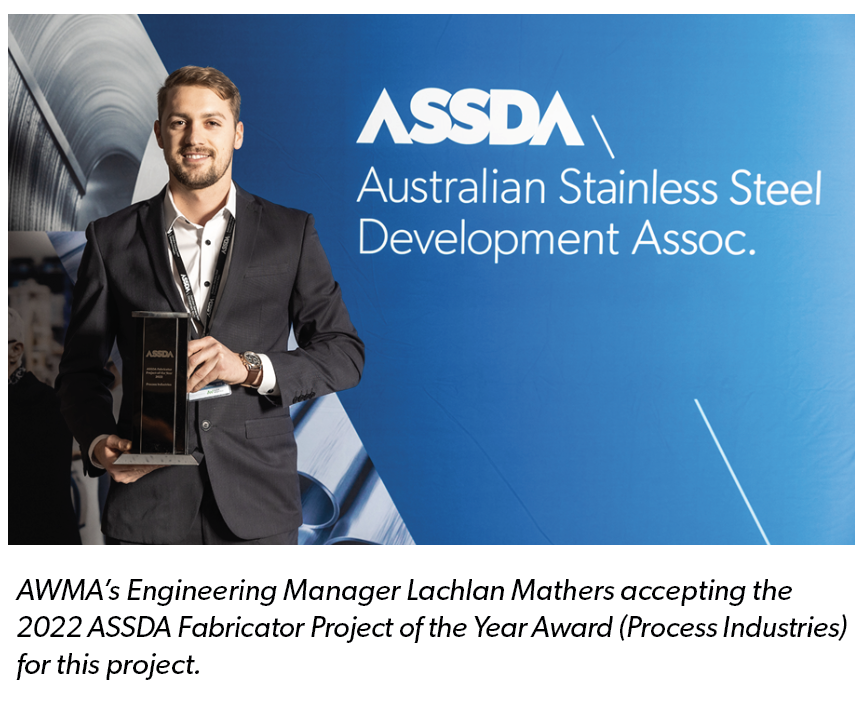
A FISH-FRIENDLY WATER EXTRACTION FACILITY
For the past six years, ASSDA Member and Accredited Fabricator AWMA Water Control Solutions have been a proud partner of Rangitata Diversion Race Management Ltd (RDRML) in delivering one of the world's largest fish-friendly water extraction facilities using stainless steel.
The Rangitata Diversion Race (RDR) plays a crucial role in extracting water from the Rangitata River in New Zealand's South Island, serving irrigation, stock water, and hydropower generation needs year-round. However, the environmental impact on native fish populations was a concern for RDRML.
To address this challenge, AWMA was awarded the design and construct contract to deliver an environmentally sustainable diversion screen solution that would allow the required flows while ensuring the safe passage of sporting fish, such as salmon and trout, as well as various native fish species back into the river system.
Over a period of five years, RDRML collaborated with consultants, ecologists, regulatory authorities, and other stakeholders to conduct extensive research to identify the most effective and viable screen solution available worldwide. This involved overseas visits to operational screening facilities, and discussions with water regulators, scientific specialists, and equipment manufacturers to gain firsthand knowledge of established screening practices. The comprehensive research led to the selection of physical, self-cleaning, wedge wire screening systems, proven through decades of successful performance and compliance with industry guidelines.
The innovative solution designed by AWMA for the RDR project featured a stainless steel screening structure that was not only self-cleaning and fish-friendly but also delivered reliable water flows with a low whole-of-life cost. It complies with fish screening guidelines, meets client requirements, and sets a new standard for innovation in intake screen design.
Three main design characteristics prioritised for the fish protection screens were aperture size, approach velocity, and self-cleaning functionality. The aperture size of the screens was tailored to meet the specific aquatic life present, considering fish species and breeding patterns. Low approach velocities prevent entrainment and impingement of debris and fish through low, even flow distribution across the entire screen area, as well as reducing head loss. The self-cleaning functionality of the screens eliminated the need for manual cleaning, minimising operational risks and increasing flow reliability. AWMA's solution incorporates internal and external brush cleaning mechanisms to efficiently remove debris, algae, and week while maintaining fish protection and optimal flow.
AWMA's design for the RDR project required seven Cylindrical T-Screens, a Flat Panel Screen, and a LayFlat Gate, all fabricated using stainless steel. The screens, fabricated from stainless steel wedge wire, offer superior self-cleaning capability when complemented with an internal and external brush cleaning system.
The use of Australian-made stainless steel wedge wire as the screen medium further enhances the durability and maintenance-free nature of the screens. The precision construction of wedge wire, with resistance welded triangular profile wires onto support rods, ensures a robust structure and maintains accurate slot dimensions throughout the 50+ year asset life expectancy in fresh water. With a smoother outer surface and easy clean characteristics, the wedge wire screens facilitate efficient brush cleaning and remain unaffected by biofouling.
The combination of high-quality stainless steel materials and innovative infrastructure design has resulted in an environmental solution that delivers unparalleled outcomes, including native fish protection, high-quality water output, reduced energy consumption, and reliable flow delivery.
AWMA invested 6,300 labour hours into this project, utilising custom-designed tooling for the efficient handling, processing, fabrication, fit-out, testing and inspection of the screen elements. Over 55 tonnes of stainless steel in various grades and surface finishes were used for the manufacture and successful implementation of the project, with the majority of stainless materials supplied by ASSDA Member, Vulcan.
The self-cleaning intake screen solution designed for this project comprises seven T-screens (14 cylinder screens) and a 30m long Flat Screen. The flat screen was required towards the end of the bypass channel where space was restricted by the tapered design of the channel.
The 14 cylinder screens were fabricated from grade 304 stainless steel wedge wire screen mediums, measuring 2.1m in diameter and 3.0m in length. 140m of grade 316 stainless steel wire rope cables, complete with stainless turnbuckles and fittings were supplied by ASSDA Member and Accredited Fabricator Arcus Wire Group for the purposes of lowering and raising the intake screens within the AWMA retrieval systems.
The seven, 8.75m high retrieval systems were each fitted with headstocks consisting of grade 304 stainless steel headstock covers to protect the grade 316 stainless steel drive shafts that were 100mm in diameter. The 8-tonne stainless steel flat panel screen measured 30m x 3.5m (105 sqm).
Approximately 1.8 tonnes of stainless steel was used to fabricate the LayFlat Water Control Gate utilised at the end of the bypass channel as a fish-friendly, overshot gate for water regulation and control.
ASSDA Member Akras Industries was also engaged during the fabrication stage in a semi- automated butt fusion welding process to ensure high strength and single-welded seam joints. Prior to installation, a pickling surface treatment was performed on all stainless steel components by AWMA using pickling spray supplied by ASSDA Member, Midway Metals.
automated butt fusion welding process to ensure high strength and single-welded seam joints. Prior to installation, a pickling surface treatment was performed on all stainless steel components by AWMA using pickling spray supplied by ASSDA Member, Midway Metals.
Stainless steel has ensured the durability, performance and longevity of the water extraction facilities while maintaining the project's commitment to environmental sustainability. Completed in late 2022, this world-class project showcases the quality and diversity of Australia's stainless steel materials, industry expertise and manufacturing capability.
The successful collaboration between AWMA and RDRML demonstrates a partnership commitment to sustainable water management and the protection of aquatic ecosystems. The RDR project stands as a testament to the effectiveness of advanced stainless steel screening technology in balancing water extraction needs with environmental preservation.

Photo credit: AWMA Water Control Solutions.
This article was featured in Australian Stainless Magazine Issue 78 (2023).